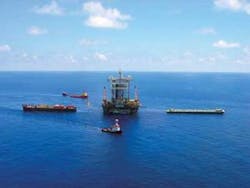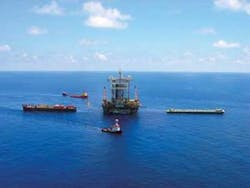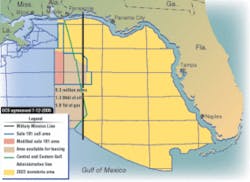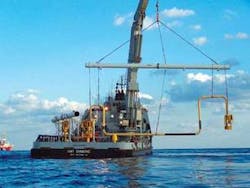GULF OF MEXICO
David Paganie • Houston
Petrobras to deploy first FPSO in US GoM
Petrobras plans to deploy the first FPSO in the US Gulf of Mexico to develop theCascade and Chinook fields located in the Walker Ridge area in water depths ranging from 7,000-9,000 ft.
Petróleo Brasileiro SA subsidiary, Petrobras America Inc. based in Houston, will operate both fields with 50% and up to 71.67% working interest, respectively. Other participants in the fields include Devon Energy and Total E&P USA Inc.
Petrobras recently acquired an additional 25% working interest in Cascade and 26.67% interest in Chinook from BHP Billiton, and an additional 15% in Chinook from Hess.
The operator says it is fasttracking development of the fields through a phased approach to achieve first oil by late 2009. Initial production will flow through two subsea wells on Cascade and one subsea well on Chinook to a moored FPSO.
The company has secured one rig and is in the process of contracting a second to conduct development drilling in the area.
According to Cascade partner, Devon, who recently increased its working interest in the field from 25% to 50%, the MMS issued a Suspension of Production (SOP) on July 31, 2006 for permission to begin commercial development of the discovery. The “Cascade Unit Agreement” area covers 23,000 acres in Walker Ridge blocks 205, 206, 249, and 250.
Meanwhile, Petrobras is developing itsCottonwood gas field, located in Garden Banks block 244 in approximately 2,297 ft of water, as a subsea tieback to an existing facility. First production is expected in early 2007.
Deepwater discoveries
Operators found commercial quantities of hydrocarbons with two deepwater wells since we last reported on Gulf drilling activity in August.
Nexen’s exploration well on theRingo prospect in Mississippi Canyon block 546 encountered approximately 150 ft of net gas pay, according to final well logs.
The Ringo discovery was drilled by theTransocean Amirante semisubmersible to a total depth of 12,808 ft in 2,500 ft of water. The operator says it is evaluating tieback options to nearby facilities. Given the well’s relative distance to production facilities, a hot-tap tie-in to a nearby gas pipeline may be considered.
The company says the field’s pre-drill reserves were estimated at 60-170 bcfe and will be confirmed with additional drilling.
Nexen is the operator of the block with a 50% working interest; Eni holds the remaining 50% interest.
Meanwhile, Chevron confirmed results of itsBig Foot discovery with a sidetrack well drilled on Walker Ridge block 29. The well was drilled one-half mile north downdip of the discovery borehole to a 24,434 ft TVD.
The company says the sidetrack encountered the same pay intervals as seen in the discovery well, with approximately 300 ft of net oil pay. Additional appraisal drilling is planned to determine the commercial extent of the field.
Chevron (operator) holds a 60% working interest in Big Foot. Partners include Anadarko with a 15% stake, and Plains E&P and Shell each with a 12.5% working interest.
Field developments
ATP says FEED work is under way for development of four of its newly acquired fields:Telemark (Atwater Valley block 62), Mirage (Mississippi Canyon block 941), Oasis (Mississippi Canyon block 943), and Morgus (Mississippi Canyon block 942).
The operator plans to install a spar close to the fields for drilling and production operations. Early design parameters for the facility include at least two risers, a 2,000-hp platform drilling rig, capacity for production of 20-30,000 b/d of oil and 60-100 MMcf/d of gas.
The facility is scheduled to be installed in the first half of 2008, with first production expected by the end of the year. ATP says total capital expenditures for this project could reach $550 million.
According to the company, previous drilling results at Telemark, Mirage, and Morgus identified approximately 190 bcfe of recoverable hydrocarbons, while an additional 60 bcfe may be recoverable through additional exploration.
ATP is 100% owner and operator of all four fields.
BP says it expects to achieve first production from itsThunder Horse field in early 2007.
According to the company, offshore repair work on theThunder Horse semi continues, including testing of its subsea equipment in preparation for start-up.
However, during a routine hydrotest, two leaks were found in a subsea manifold, pushing back the targeted first production date, says BP. The damaged subsea equipment will be replaced.
The company says it is taking a precautionary approach and is fully investigating the events before starting up the platform. BP anticipates it will receive regulatory approval to introduce hydrocarbons into the facilities in the third quarter.
The BP-operated Thunder Horse field was originally expected to start-up in 2005, but that date was severely delayed when the field’s semisubmersible production facility incurred problems during installation causing it to list 20-30°.
The Thunder Horse field is in Mississippi Canyon block 778 in 6,050 ft of water.
Anadarko delayed completion operations on itsGenghisKhan field over concerns of mooring a rig near its tieback production facility, Marco Polo, and associated subsea infrastructure during the peak hurricane season.
Completions operations are now scheduled for late 4Q06, with first production expected in 1Q07. Start-up was originally scheduled for mid-2006.
Meanwhile, all subsea infrastructure has been installed on the field, and topsides modifications onMarco Polo are approximately 90% complete.
The Anadarko-operatedGenghis Khan field is in Green Canyon block 652 in 4,300 ft of water. The field is being developed via 3-mi subsea tieback to the Marco Polo TLP in Green Canyon block 608.
Market sources indicate that a competitive tender has been launched for selection of a feasible development solution for the Chevron-operatedJack discovery on Walker Ridge block 759 in 7,000 ft of water.
At print, partners in the project were reviewing the discovery well’s production test results, conducted by Transocean’s semisubmersible,Cajun Express.
According to one partner, “This is the first production test of a Lower Tertiary (Wilcox) reservoir in the deepwater Gulf, an important step in determining the commercial viability of this play.”
Rig exodus
Two more rigs will be leaving the Gulf of Mexico this year for term contracts in the Middle East. Rowan secured contracts for two of its Class 116-C jackups for operations offshore Qatar beginning late 2006 or early 2007.
Both contracts are for a two-year term with an option to extend one additional year. TheGilbert Rowe and Rowan Paris will begin relocation in the third quarter and should be completed by the end of the year. The company estimates total revenues for the contracts at around $278 to $293 million.
“These term contracts offer revenues and earnings visibility that is not available in the GoM market, while assisting us in achieving our goal to geographically diversify our drilling fleet,” says Danny McNease, Rowan chairman and CEO.
Analyst reports estimate the rigs will receive day rates in the range of $196,000.
According to Saudi Aramco, it currently has 17 rigs drilling offshore and expects to have 19 in operation by the end of the year, while it is planning for additional rigs from the GoM to arrive in the region next year.
US Senate vs. House
A conference committee has been assembled to reconcile differences between two separate pieces of legislation on OCS leasing passed by the Senate and House of Representatives.
By a vote of 71-25, the US Senate adopted the Gulf of Mexico Energy Security Act (S.3711) which would open an additional 8.3 million acres in the GoM for leasing.
The Senate passed the Domenici (R-NM)-led legislation that would authorize E&P in designated sections of Lease Sale Area 181 and 181 South, where it is estimated to hold 1.3 Bbbl of oil and 6 tcf of gas - enough to power 16 million homes for 15 years, according to Domenici’s estimates.
The bill addresses Florida’s concerns by establishing a moratorium within 125 mi of the state’s coast, while excluding all acreage east of the military mission line and portions of the Sale 181 Area from leasing through June 30, 2022.
In addition, the proposed legislation would allocate 37.5% of royalties from the newly established leasing area to Texas, Louisiana, Mississippi, and Alabama.
The next step is for the Senate and House of Representatives, which on June 29 passed a much broader drilling bill - the Deep Ocean Energy Resources Act - to reach agreement on a final version.
Anadarko completes acquisition of Kerr-McGee
Anadarko has completed the acquisition of Kerr-McGee Corp. in an all-cash transaction totaling $16.4 billion, or $70.50 per Kerr-McGee share, plus the assumption of net debt and other liabilities estimated at $1.6 billion.
Kerr-McGee’s year-end 2005 proved reserves totaled 898 MMboe, of which approximately 62% was natural gas. Proven undeveloped reserves represented 30% of the total. Production in 2006 was expected to reach 92 MMboe, with natural gas representing approximately 60% of the total.
Anadarko says it expects to ultimately recover more than 3.1 Bboe from Kerr-McGee’s properties, at a full-cycle cost of approximately $39.2 billion ($12.40/boe), including the acquisition cost.
Kerr-McGee’s largest property concentrations are in the deepwater GoM and onshore in the Rockies. Its Gulf properties include 504 deepwater blocks comprising seven operated and three non-operated producing fields, five operated and three non-operated discoveries in various stages of development, and four additional prospects expected to be drilled this year.
Deep Marine Technology’s 240 ft DP MSV,DMT Diamond, performed a wide range of activities during its first year of service in the Gulf of Mexico, including installation of seven ridged jumpers ranging from 55-93 in. in 4,400 ft of water, setting of 11 steel and 14 electrical flying leads, pre- and post-route surveys, riser removal, inspections, commissioning, and module installation on subsea trees. The vessel is equipped with a 50-ton knuckle boom crane, subsea equipment winch with 10,000 ft of 1.5-in. cable, accommodations for 36 (expandable to 44) people, and a 150-hp, 10,000-ft Triton XLS work-class ROV. The company says it is adding to its fleet a 292-ft MSV, DMT Emerald, by the fourth quarter.



